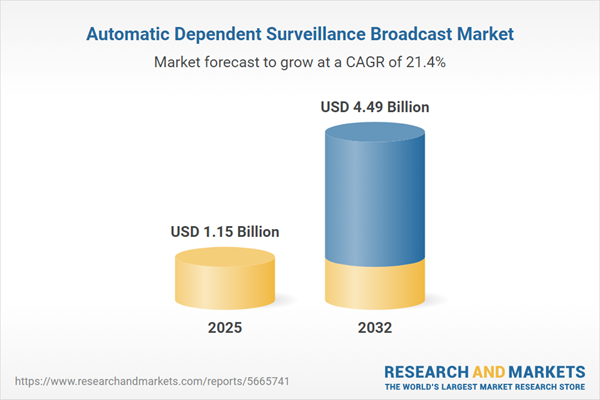Speak directly to the analyst to clarify any post sales queries you may have.
Automatic Dependent Surveillance-Broadcast (ADS-B) technology is redefining global aviation safety oversight by delivering unparalleled real-time tracking and data-driven decision support. As adoption accelerates, the ADS-B market stands as a foundational enabler of modern air traffic management and operational efficiency for airlines, service providers, and regulators.
Market Snapshot: Automatic Dependent Surveillance-Broadcast
The Automatic Dependent Surveillance-Broadcast market grew from USD 953.20 million in 2024 to USD 1.15 billion in 2025 and is forecast to achieve USD 4.49 billion by 2032, supported by a CAGR of 21.39%.
Scope & Segmentation
This report delivers detailed analysis of the evolving Automatic Dependent Surveillance-Broadcast ecosystem. The research addresses comprehensive segmentation by platform, component, application, end user, regions, and key market participants.
- Platform Type: Civil aircraft (business, commercial, general aviation), military aircraft, UAV, ground stations (fixed and portable), and satellite-based solutions
- Component: Hardware and software data processors, multilateration and Mode S receivers, 1090ES and UAT transceivers
- Application: En route, oceanic, and terminal air traffic management, coastal surveillance, collision avoidance, search and rescue
- End User: Air navigation service providers, commercial airlines, cargo carriers, military operators, private operators, UAV service providers
- Regional Coverage: North America (US, Canada, Mexico), Latin America (Brazil, Argentina, Chile, Colombia, Peru), Europe (UK, Germany, France, Russia, Italy, Spain, Netherlands, Sweden, Poland, Switzerland), Middle East (UAE, Saudi Arabia, Qatar, Turkey, Israel), Africa (South Africa, Nigeria, Egypt, Kenya), Asia-Pacific (China, India, Japan, Australia, South Korea, Indonesia, Thailand, Malaysia, Singapore, Taiwan)
- Key Companies: Garmin Ltd., Honeywell International Inc., Collins Aerospace, Inc., Thales S.A., L3Harris Technologies, Inc., Rohde & Schwarz GmbH & Co KG, Frequentis AG, Appareo Systems, LLC, uAvionix Corporation, Becker Avionics GmbH
Key Takeaways: Strategic Insights for ADS-B Stakeholders
- ADS-B implementation is rapidly transforming airspace monitoring, driving increased operational awareness and safety for modern fleets.
- Integration of machine learning in multilateration and data processing is enabling both proactive risk mitigation and advanced analytics for route optimization.
- Harmonized regulatory standards are facilitating broad international adoption, while cooperative frameworks ensure cross-border infrastructure compatibility.
- Emerging markets, particularly in Asia-Pacific and parts of Africa, are leveraging domestic manufacturing and technology transfer to accelerate deployments.
- Industry leaders are investing in modular, software-driven architectures to remain agile amidst evolving compliance mandates and technology upgrades.
- Collaborations across defense, civil aviation, and satellite sectors are expanding the operational reach of ADS-B, especially in previously underserved regions.
Tariff Impact: Navigating US Trade Actions
The introduction of US tariffs in 2025 has prompted stakeholders to reconfigure sourcing, partnerships, and deployment strategies for ADS-B components. Manufacturers are reassessing supply models to counteract higher duties on transceivers and processors, while service providers prioritize critical project phases to manage budget constraints. Localized production initiatives and modular component design are supporting industry resilience amid ongoing trade uncertainties.
Methodology & Data Sources
Research findings are rooted in interviews with aviation authorities, equipment makers, and end users, combined with analysis of regulatory directives and technical documentation. Quantitative modeling aligns with market activity and regional benchmarks, while validation is achieved through cross-examination of live deployment data.
Why This Report Matters
- Senior executives gain clear visibility into evolving ADS-B opportunities, risk areas, and procurement considerations.
- The report helps frame investment decisions and partnership strategies in line with current regulatory and technological shifts.
- Actionable insights inform future-proofing of ADS-B deployments and supply chain optimization in response to global market pressures.
Conclusion
Automatic Dependent Surveillance-Broadcast continues to reshape the global aviation landscape, driven by innovation, regulation, and market collaboration. Decision-makers equipped with these insights are positioned to optimize strategy, minimize disruption, and sustain operational excellence as ADS-B adoption expands worldwide.
Additional Product Information:
- Purchase of this report includes 1 year online access with quarterly updates.
- This report can be updated on request. Please contact our Customer Experience team using the Ask a Question widget on our website.
Table of Contents
3. Executive Summary
4. Market Overview
7. Cumulative Impact of Artificial Intelligence 2025
Companies Mentioned
The companies profiled in this Automatic Dependent Surveillance Broadcast market report include:- Garmin Ltd.
- Honeywell International Inc.
- Collins Aerospace, Inc.
- Thales S.A.
- L3Harris Technologies, Inc.
- Rohde & Schwarz GmbH & Co KG
- Frequentis AG
- Appareo Systems, LLC
- uAvionix Corporation
- Becker Avionics GmbH
Table Information
| Report Attribute | Details |
|---|---|
| No. of Pages | 187 |
| Published | October 2025 |
| Forecast Period | 2025 - 2032 |
| Estimated Market Value ( USD | $ 1.15 Billion |
| Forecasted Market Value ( USD | $ 4.49 Billion |
| Compound Annual Growth Rate | 21.3% |
| Regions Covered | Global |
| No. of Companies Mentioned | 11 |









